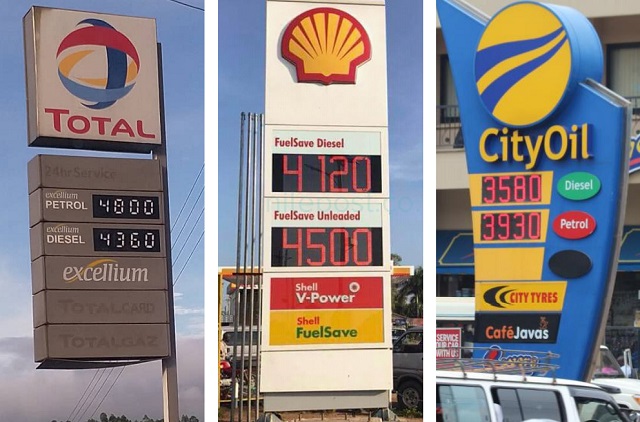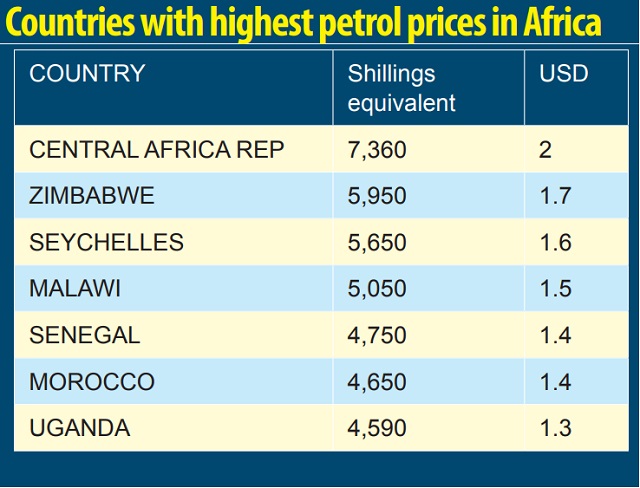
Experts explain why prices more likely to go up
Kampala, Uganda | THE INDEPENDENT | On November 22, 2021 when this article was written, the average price of petrol at pump station in Uganda was Shs4,590 (approx. US$1.3) per litre which was the highest among member states of the East African region.
Tanzania had the lowest price expressed in Uganda currency equivalents at about Shs3,780 per litre, Rwanda Shs4,060, Kenya, Shs4,180, and Burundi the second highest in the region at equivalent of Shs4290.
The highest price of petrol at the pump in Africa was in the Central African Republic at equivalent of Shs7,360 and the lowest price was in Nigeria at equivalent of Shs1,440. The highest price in the world for petrol at the pump was in Hong Kong at equivalent of Shs9,350 per liter.
According to Global Petrol Prices.com, which compiles the global data prices, the average price of gasoline around the world at the time was US$1.23 per litre. This means that Uganda, at US$1.3 per litre was not far above average.
But critically, just three days earlier the price of petrol in Uganda was equivalent to US$1.2 which was the seventh highest price on the African continent. But in a short three days, it had jumped to US$1.3 which placed Uganda as the country with the fourth highest price of petrol on the continent.
And as Global Petrol Prices.com explains, as a general rule, richer countries have higher prices while poorer countries and the countries that produce and export oil have significantly lower prices. That means, Uganda which is a relatively poor country would be expected to have low petrol prices.
Fuel prices have a direct domino impact on almost every aspect of the economy. Usually, the effect starts with the transporters who hike their rates and traders who seek to transfer the increased costs to consumers.
But as Global Petrol Prices.com again explains, the differences in prices across countries are due to the various taxes and subsidies for fuel. All countries have access to the same petroleum prices of international markets but then decide to impose different taxes. As a result, the retail price of fuel is different in each country.
Uganda, which imposes a specific tax on petrol and diesel, in the 2020/21 budget increased the tax on the two products by Shs100. This meant that the government would be collecting Shs1,300 as tax from each litre of petrol sold instead of the previous Shs1,200 per litre. The tax on diesel equally rose from Shs 880 to Shs 980.
Fuel prices vary per station in Uganda but the average price for petrol at the pump in June, when the budget was read, was about Shs3, 700 and diesel Shs3,200 per litre. At those prices, the government imposed tax component in the price of petrol per litre sold was 35% and 30% per litre of diesel. That means that prices would be far lower if the government, instead of imposing a tax, introduced a tax subsidy of fuel products.
 Govt interventions
Govt interventions
In Nigeria; the country with the lowest cost of petrol at the pump on the African continent, the government subsidises the price by about 40% under the Price Control Act which prohibits selling fuel above the government regulated price. It was introduced in 1977 when, as now, there was a worldwide increase in the price of fuel.
The Rwanda government introduced subsidies on petrol and diesel in May 2021 just as global oil prices were beginning to rise. The government also sets prices of fuel.
On Oct.15 it announced adjustments to its intervention. The government set the price of petrol at Rwf 1143 per litre from Rwf1,088 effective October 16 to December 14. The government kept the price of diesel unchanged at Rwf 1054 per litre. Without the subsidy, the price of petro would have risen by Rwf 110 and diesel by Rwf 80.
The government subsidises diesel more because 70% of fuel consumed in Rwanda is diesel which is used by public transport buses, commercial trucks, and industrial machines and equipment. The idea is to cushion citizens against the negative domino effect of rising fuel prices on cost of living, such as inflation.
The Kenyan government on Nov.15 announced it would pay fuel dealers a fuel subsidy to keep pump prices unchanged. Fuel dealers will get their full margins equivalent to about Shs390 per litre of super petrol and diesel sold. The government uses a Petroleum Development Levy to cushion consumers and the economy from high prices.
In September, fuel prices in Kenya rose to the highest level in Kenya’s history after the government attempted to discontinue the subsidy scheme on fuel that was introduced in April. Petrol jumped by Ksh7.58 a litre to Ksh134.72 (Approx. UShs4,270 and diesel Ksh7.94 to Ksh115.6 (Approx. UShs3,660).
Tanzania’s Energy and Water Utility Regulatory Authority (EWURA), which fixes the prices of fuel, in early November announced that they would remain unchanged despite a surge globally. In some cases, such as that of Diesel consumed in the capital, Dar es Salaam, the price would go down. EWURA said without the government’s interventions the prices risen to, for example, TzShs2,492 per litre of petrol and diesel at Tz2,304 per litre at the ports. Prices vary at the pump across the country. President Samia Suluhu Hassan in July announced measures to lower prices of petroleum products. They included reduction of charges, levies and fees on the products.
The Uganda Minister of State for Energy, Sidronius Okaasai Opolot, recently told journalists that the government will not intervene to regulate the skyrocketing fuel prices across the country.
“The increase in fuel prices is a global trend, we can do little as a country because the price of crude oil internationally has gone up,” Opolot said on Nov.19, “You cannot escape it.”
Opolot said, in any case, even if the government was to consider any intervention it does not have the resources to finance it.
“We do not really have the resources to say that may be let us subsidise for the consumers, we cannot do that,” Opolot said.
Opolot said Ugandans should not be alarmed, because the country’s fuel pricing is still the best in the region.
“When you consider our petroleum products and their pricing in the region, Uganda’s pricing is still cheap,” he said. Clearly, based on the figures in this article, the minister’s position appears to be inaccurate.
There are also media reports quoting the Principal Communications Officer of the Ministry of Energy, Solomon Muyita, saying the government has set a reserve price which oil companies cannot cross.
Muyita reportedly said none of the oil companies has so far surpassed the reserve price but, if they do, the government can intervene.
“As we speak, our prices are still competitive, no one has exceeded the reserve price yet,” he reportedly said.

Higher price ahead
The bad news, according to global oil sector experts, is that fuel prices at the pump look set to climb even higher than they are today.
This after U.S. petrol futures traded close to $2.3 a gallon in the fourth week of November, rebounding from a near two-month low hit on Nov. 19.
Experts said the rebound happened because coordinated oil reserve releases by the U.S., South Korea, India, China, and Japan turned out to be less than what markets expected.
U.S. President Joe Biden announced that America will make available up to 50 million barrels of oil (MMbbl) only. Of this 18 MMbbl will come from previously planned sales already authorised by the U.S. Congress.
Also, contributions from international partners came rather short of expectations; South Korea said it will release 3.8 MMbbl, Indian officials said the nation will release 5 MMbbls, and Japan will make available 4.2 MMbbl. The Chinese authorities did not reveal official figures, but estimates point to somewhere between 7 and 15 MMbbl, according to Forbes.
Global fuel prices are rising sharply because oil supply has not kept up with demand as economies recover from the COVID-19 imposed lockdowns and the Organisation of Petroleum Exporting Countries (OPEC) maintains a slow pace of increasing output.
According to Forbes, whether fuel pump prices fall in 2022 depends on two groups of producers who are struggling to increase oil output in the wake of the pandemic: OPEC and its allies and U.S. shale firms.
Oil prices have increased significantly from their pandemic lows and are substantially higher than 2019 levels. They are however lower than the US$100 price before the U.S introduced fracking.
Oil prices fluctuate more than most consumer prices. Big gains are often followed by large declines, and vice versa, so the recent uptick cannot be projected into the distant future.
Current oil prices reflect not only current supply and demand, but also long-term issues. Traders can stock up on oil if they anticipate higher demand—and thus higher prices—in the future. Or they can dump their inventory if they get pessimistic.
Thus, according to experts, the current prices reflect current opinion about the long-term supply-demand balance in the market. The recent run-up, which doubled prices in 12 months, reflects a global economy switching from pandemic-induced recession to long-term growth.
As a result, some experts say the current price of about $80 (as of mid-November) a barrel is reasonable as long as the world continues to make progress on keeping Covid-19 infection and death rates low.
****
 The Independent Uganda: You get the Truth we Pay the Price
The Independent Uganda: You get the Truth we Pay the Price






They should redo this survey now that the price of fuel is ug shs. 5200
Uganda is still a land locked country with no coastline.